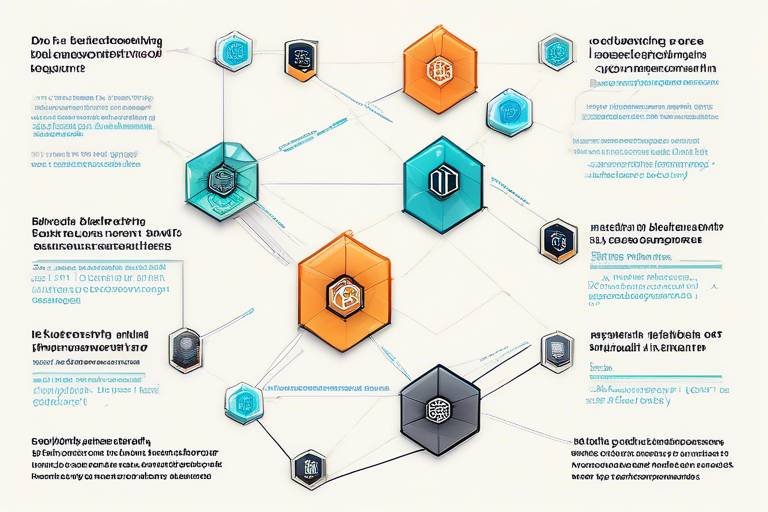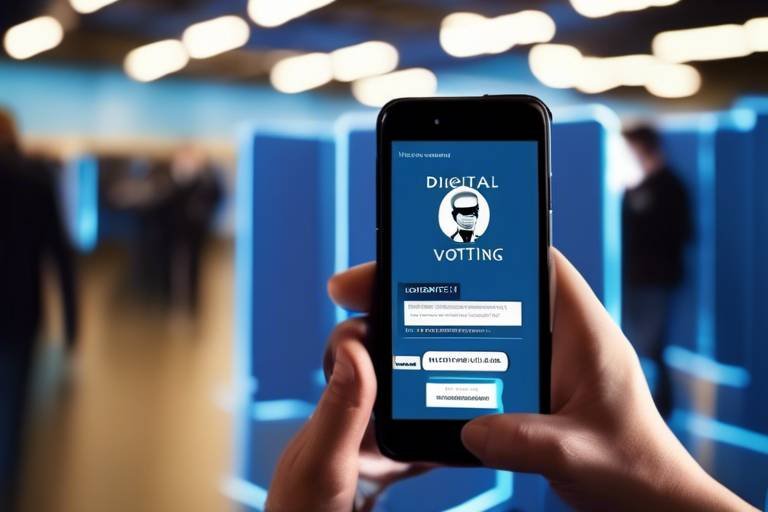How Blockchain Can Enhance Accountability in Nonprofits
In today's fast-paced world, nonprofits face increasing pressure to demonstrate their accountability and transparency. With the rise of technology, particularly blockchain, there is a unique opportunity for these organizations to revolutionize how they operate. Imagine a world where every donation is tracked, every expense is transparent, and every stakeholder can verify the integrity of the organization with just a few clicks. This is not just a dream; it’s a reality that blockchain technology can help create.
Blockchain, at its core, is a decentralized ledger system that records transactions across many computers in a way that the registered transactions cannot be altered retroactively. This ensures that the data is secure, transparent, and accessible to all parties involved. For nonprofits, this means that every donation, expenditure, and operational decision can be recorded in a manner that is immutable and verifiable. With blockchain, accountability becomes not just a goal but a built-in feature of the organizational process.
But why is accountability so crucial for nonprofits? For starters, it builds trust among stakeholders. Donors want to know that their contributions are being used effectively and responsibly. When organizations can provide clear evidence of how funds are being utilized, it fosters a sense of confidence and encourages further donations. Moreover, maintaining compliance with regulations and standards is essential for nonprofits to avoid legal issues and ensure they are operating within the law.
Despite the clear advantages, many nonprofits struggle with accountability. Common challenges include financial mismanagement, lack of transparency, and difficulties in tracking donations and expenditures. These issues can lead to a significant loss of trust from donors and stakeholders. For instance, financial mismanagement can result in scandal, which tarnishes an organization’s reputation and can take years to rebuild. Transparency gaps can hinder effectiveness, as stakeholders may feel disconnected from the organization’s operations.
Now, let’s explore how blockchain technology can address these challenges. By implementing blockchain solutions, nonprofits can enhance transparency, improve tracking of donations, and ultimately increase trust among stakeholders. The ability to provide real-time access to financial data allows organizations to demonstrate their accountability in a way that was previously unattainable.
As we move forward, it's essential for nonprofits to consider how they can integrate blockchain into their operations. This involves choosing the right blockchain platform, which can be a daunting task. Factors to consider include scalability, cost, security features, and ease of use. Additionally, training and educating staff on blockchain technology is crucial. This ensures that everyone involved understands how to utilize the system effectively and maximize its benefits.
Looking ahead, the future of nonprofits with blockchain technology is bright. As more organizations adopt this innovative technology, we can expect significant shifts in donor expectations and engagement. Donors will likely demand greater transparency, and nonprofits that embrace blockchain will be well-positioned to meet these needs. The potential for innovation is immense, and those who adapt will thrive in this new landscape.
- What is blockchain technology?
Blockchain technology is a decentralized ledger system that records transactions securely and transparently across multiple computers. - How can blockchain improve accountability in nonprofits?
By providing a transparent and immutable record of donations and expenditures, blockchain enhances trust and accountability. - What challenges do nonprofits face regarding accountability?
Common challenges include financial mismanagement, lack of transparency, and difficulties in tracking funds. - What should nonprofits consider when choosing a blockchain platform?
Nonprofits should evaluate scalability, cost, security features, and ease of use when selecting a blockchain platform. - Why is staff training important for blockchain implementation?
Training ensures that staff can effectively use the technology and maximize its benefits for the organization.

Understanding Blockchain Technology
Blockchain technology is often shrouded in mystery, but at its core, it’s a decentralized ledger system that records transactions across many computers in such a way that the registered transactions cannot be altered retroactively. Think of it as a digital notebook that everyone can see, but no one can erase or change without consensus from the group. This creates a level of transparency that is revolutionary, especially for sectors like nonprofits, where trust and accountability are paramount.
One of the most fascinating features of blockchain is its immutability. Once data is entered into the blockchain, it becomes nearly impossible to change or delete. This characteristic is akin to writing in ink rather than pencil; it ensures that the information remains intact and can be verified at any time. Additionally, blockchain operates on a peer-to-peer network, meaning that every participant in the network has access to the entire chain of transactions. This not only enhances security but also fosters a sense of community and shared responsibility.
To further understand how blockchain functions, let's break down its key components:
- Blocks: Each block contains a list of transactions. Once a block is filled, it is added to the chain, hence the name "blockchain."
- Nodes: These are the computers that participate in the blockchain network. Each node maintains a copy of the entire blockchain and validates new transactions.
- Consensus Mechanisms: This is the process through which nodes agree on the validity of transactions. Different blockchains use various consensus algorithms, such as Proof of Work or Proof of Stake.
The combination of these components creates a system that is not only secure but also highly efficient. In traditional systems, transactions can take time to process and may require intermediaries, which can slow down operations and increase costs. Blockchain eliminates the need for these middlemen, allowing for faster and cheaper transactions. This efficiency is particularly beneficial for nonprofits, as it can lead to more funds being directed towards their core missions rather than administrative overhead.
As we delve deeper into the implications of blockchain for nonprofits, it’s essential to recognize that its potential extends beyond mere financial transactions. Blockchain can also be utilized for smart contracts, which are self-executing contracts with the terms of the agreement directly written into code. This can automate various processes within nonprofits, such as grant disbursements and donation tracking, thus enhancing both accountability and efficiency.
In summary, understanding blockchain technology is crucial for nonprofits looking to enhance their operations. By leveraging its features, organizations can improve transparency, build trust with stakeholders, and ensure that their resources are used effectively. As we move forward, the integration of blockchain into the nonprofit sector could very well redefine how these organizations operate and interact with their communities.

Importance of Accountability in Nonprofits
Accountability in nonprofits isn't just a buzzword; it's the very backbone of their credibility and effectiveness. Imagine a nonprofit as a bridge connecting generous donors to those in need. If that bridge is shaky or poorly constructed, it risks collapsing under the weight of expectations. This is where accountability plays a crucial role. It builds trust with stakeholders, ensuring that every dollar donated is used responsibly and transparently. When donors feel confident that their contributions are making a real difference, they are more likely to give again and even encourage others to join in.
Moreover, accountability helps nonprofits maintain compliance with various regulations and standards. Just as a ship needs a compass to navigate through turbulent waters, nonprofits need clear guidelines to steer their operations. This compliance not only protects the organization legally but also enhances its reputation. A nonprofit that consistently demonstrates accountability is more likely to attract partnerships, grants, and media attention, ultimately leading to greater impact.
Another vital aspect of accountability is the ability to ensure responsible use of funds. Nonprofits often operate on tight budgets, and every penny counts. Without a solid accountability framework, it can be all too easy for funds to be mismanaged or misallocated. This can lead to devastating consequences, such as loss of donor trust and potential funding. In fact, a study by the Nonprofit Finance Fund revealed that over 40% of nonprofits reported financial mismanagement as a significant challenge. This statistic underscores the need for robust systems that not only track expenditures but also provide transparency to all stakeholders involved.
In essence, accountability is not merely a requirement; it is a strategic advantage for nonprofits. It allows them to showcase their impact, engage more effectively with their communities, and ultimately fulfill their missions. By embracing accountability, nonprofits can transform their operations and enhance their relationships with donors, beneficiaries, and the public at large.
As we explore the challenges faced by nonprofits in the next section, it’s important to remember that accountability is not just about avoiding pitfalls; it's about building a solid foundation for future growth and success.

Challenges Faced by Nonprofits
Nonprofits operate in a complex landscape where the stakes are high, and the margin for error is slim. One of the most pressing issues they face is accountability. Without proper accountability, nonprofits can find themselves navigating a treacherous path filled with obstacles that can undermine their mission and erode trust with stakeholders. Among these challenges, financial mismanagement, lack of transparency, and tracking donations effectively stand out as significant hurdles.
Financial mismanagement is a particularly daunting challenge. Imagine a nonprofit that receives a generous donation intended for community development projects. If the funds are not managed correctly, they could be misallocated or even lost to fraud. This not only impacts the immediate projects but also tarnishes the organization’s reputation. In fact, studies have shown that a single incident of financial mismanagement can lead to a 60% drop in donor trust, which can take years to rebuild.
Another critical issue is the lack of transparency. Many nonprofits struggle to provide clear insights into how funds are being utilized. This opacity can lead to skepticism among donors and stakeholders who want to see their contributions making a tangible impact. When donors are left in the dark, they may hesitate to contribute again, fearing their money might not reach its intended destination. In a world where information is at our fingertips, the demand for transparency has never been higher.
Moreover, tracking donations and expenditures effectively poses a significant challenge. Nonprofits often rely on outdated systems or manual processes that are prone to errors. This can lead to discrepancies that not only confuse accounting but also create a lack of accountability. For instance, if a donor inquires about the status of their contributions, a nonprofit may struggle to provide a clear answer, leading to frustration and a potential loss of future support.
To sum it up, the challenges faced by nonprofits are multifaceted. Addressing these issues requires a comprehensive approach that prioritizes accountability and transparency. Implementing solutions, such as blockchain technology, can significantly alleviate these challenges, ensuring that nonprofits can operate more efficiently and maintain the trust of their donors.
- What are the main challenges nonprofits face today?
Nonprofits often struggle with financial mismanagement, lack of transparency, and difficulties in tracking donations and expenditures. - How does financial mismanagement affect nonprofits?
Financial mismanagement can lead to a loss of donor trust, which is crucial for the sustainability of nonprofit organizations. - Why is transparency important for nonprofits?
Transparency helps build trust with stakeholders, ensuring that donors feel confident their contributions are making a positive impact. - Can blockchain technology help nonprofits?
Yes, blockchain can enhance transparency, improve tracking of donations, and increase trust among stakeholders.

Financial Mismanagement Issues
Financial mismanagement is a serious issue that can plague nonprofits, leading to devastating consequences not just for the organization itself but also for the communities they serve. Imagine a nonprofit that has been entrusted with the hard-earned donations of generous individuals, yet due to poor financial practices, those funds are misallocated or, worse, lost. This scenario is not just hypothetical; it has happened to numerous organizations, eroding trust and damaging reputations.
One common problem is the lack of proper accounting systems. Many nonprofits operate on tight budgets and may not have the resources to invest in sophisticated financial management tools. As a result, they often rely on outdated methods that can lead to errors and oversights. For instance, without a reliable system to track donations and expenditures, funds can easily become mismanaged, leading to discrepancies that can raise red flags for donors and regulatory bodies alike.
Additionally, financial mismanagement can stem from inadequate training for staff members. If team members are not well-versed in financial protocols, they may inadvertently mishandle funds or fail to adhere to compliance standards. This lack of knowledge can create a domino effect, where one mistake leads to another, ultimately compromising the organization’s integrity.
To illustrate the impact of financial mismanagement, consider the following table that highlights some notorious cases:
| Organization | Issue | Consequences |
|---|---|---|
| Nonprofit A | Misappropriation of funds | Loss of donor trust, legal action |
| Nonprofit B | Inadequate financial reporting | Loss of funding, increased scrutiny |
| Nonprofit C | Failure to comply with regulations | Fines, potential closure |
The consequences of these financial mismanagement issues extend far beyond immediate financial losses. They can lead to a significant decline in donor confidence, making it challenging for nonprofits to secure future funding. In a world where transparency and accountability are paramount, any hint of financial mismanagement can result in a long-lasting negative impact on an organization's reputation.
In summary, financial mismanagement is a multifaceted issue that can stem from a variety of factors, including inadequate systems, lack of staff training, and poor oversight. Nonprofits must prioritize financial accountability to safeguard their missions and maintain the trust of their stakeholders. By embracing solutions like blockchain technology, they can create a more robust framework for financial management, ensuring that every dollar is accounted for and used effectively.
- What is financial mismanagement? Financial mismanagement refers to the improper handling of an organization's financial resources, which can lead to errors, fraud, and a lack of transparency.
- How can nonprofits prevent financial mismanagement? Nonprofits can prevent financial mismanagement by implementing robust accounting systems, providing staff training, and adopting technologies like blockchain for enhanced transparency.
- What are the consequences of financial mismanagement for nonprofits? Consequences can include loss of donor trust, legal repercussions, and potential closure of the organization.

Transparency Gaps
Transparency is the lifeblood of any nonprofit organization. When stakeholders—donors, volunteers, and the community—feel that they are left in the dark, trust begins to erode. Imagine a nonprofit as a ship sailing through uncharted waters; without clear visibility, how can anyone be sure it’s headed in the right direction? Unfortunately, many nonprofits face significant that can hinder their effectiveness and undermine their mission.
One of the primary issues contributing to these gaps is the lack of real-time data sharing. In many cases, financial records and operational updates are not readily available to stakeholders. This absence of information can create an atmosphere of suspicion, leading to questions about how funds are being used and whether they are making a meaningful impact. For instance, if a donor contributes to a specific project but has no visibility into how the funds are allocated, they may feel disconnected and question the organization’s integrity.
Moreover, traditional accounting methods often involve complex processes that can obscure financial transactions. When a nonprofit relies on outdated systems, it becomes challenging to track donations and expenditures accurately. This could lead to situations where funds are mismanaged or misreported, further widening the transparency gap. A study conducted by the Nonprofit Finance Fund revealed that over 40% of nonprofits reported having difficulty in understanding their financial health, which is a clear indicator of the need for better transparency practices.
To tackle these transparency gaps, nonprofits need to adopt more effective communication strategies. They can implement regular updates and reports that are easily accessible to stakeholders. Utilizing technology, such as blockchain, can significantly enhance transparency by providing a decentralized and immutable record of all transactions. With blockchain, every donation is recorded and can be traced back to its source, ensuring that stakeholders can see exactly how their contributions are being used.
In conclusion, addressing transparency gaps is not just about improving operations; it’s about building a culture of trust and accountability. By embracing new technologies and committing to clear communication, nonprofits can bridge these gaps and foster stronger relationships with their stakeholders. After all, in a world where transparency is increasingly demanded, those who adapt will not only survive but thrive.

Benefits of Blockchain for Nonprofits
The integration of blockchain technology into the nonprofit sector is not just a trend; it’s a transformative movement that promises to redefine how organizations operate. Imagine a world where every donation is tracked transparently, where stakeholders can see exactly how their contributions are being utilized, and where trust is built on the foundation of immutable records. This is not a distant dream but a tangible reality that blockchain can offer. By enhancing transparency, improving tracking of donations, and increasing trust among stakeholders, blockchain holds the key to a more accountable nonprofit landscape.
One of the most significant benefits of blockchain is its ability to promote transparency. In traditional nonprofit operations, donors often find themselves in the dark about how their funds are being spent. With blockchain, every transaction is recorded on a decentralized ledger that is accessible to all stakeholders. This means that donors can track their contributions in real-time, seeing exactly where their money goes—from the moment it’s donated to its final destination. This level of transparency not only reassures donors but also encourages them to contribute more, knowing their funds are being used responsibly.
Moreover, blockchain enhances the tracking of donations. In many cases, nonprofits struggle with tracking how donations are allocated and spent, leading to inefficiencies and potential mismanagement. Blockchain simplifies this process by providing a clear and auditable trail of funds. For instance, if a nonprofit receives a donation earmarked for a specific project, blockchain can ensure that the funds are used exclusively for that project. This not only minimizes the risk of mismanagement but also strengthens the organization’s reputation among its supporters.
Furthermore, the deployment of blockchain technology can significantly increase trust among stakeholders. In an age where skepticism towards organizations is prevalent, nonprofits can leverage blockchain to build credibility. Donors and stakeholders can independently verify transactions and ensure that funds are being used as intended. This level of accountability can lead to stronger relationships with donors, increased funding opportunities, and a more engaged community. The trust built through blockchain can transform the donor experience, making them feel more connected and invested in the mission of the nonprofit.
In addition to these benefits, blockchain also offers enhanced security. The decentralized nature of blockchain means that data is stored across multiple nodes, making it nearly impossible for a single entity to manipulate or alter the records. This level of security is vital for nonprofits that handle sensitive information, such as donor details and financial transactions. By adopting blockchain, nonprofits can protect their data from fraud and cyber threats, ensuring that both the organization and its supporters are safeguarded.
To sum it up, the benefits of blockchain for nonprofits are profound and far-reaching. With its capacity to enhance transparency, improve tracking, increase trust, and bolster security, blockchain is set to revolutionize the nonprofit sector. As organizations begin to embrace this technology, they will not only improve their operational efficiency but also foster a culture of accountability that can lead to greater impact and sustainability in their missions.
- What is blockchain technology? Blockchain is a decentralized digital ledger that records transactions across many computers in a way that ensures the security and transparency of data.
- How can blockchain improve transparency in nonprofits? By providing a public ledger of transactions, blockchain allows donors and stakeholders to see how funds are allocated and spent.
- What are the security benefits of using blockchain? Blockchain's decentralized nature makes it highly secure against fraud and cyber threats, protecting sensitive donor information.
- Can blockchain help in tracking donations? Yes, blockchain enables real-time tracking of donations, ensuring that funds are used for their intended purpose.

Implementing Blockchain Solutions
As the world of technology continues to evolve, nonprofits find themselves at a crossroads where innovation and accountability meet. Implementing blockchain solutions can seem daunting, but with the right approach, it can transform the way organizations operate. So, how can a nonprofit start this journey? It's all about taking the right steps and ensuring that the technology integrates seamlessly with existing systems.
First and foremost, nonprofits should conduct a thorough assessment of their current operations. This involves identifying areas where blockchain could enhance transparency and efficiency. For instance, tracking donations and expenditures becomes significantly easier with blockchain, as each transaction is recorded in a secure, immutable ledger. This not only provides a clear audit trail but also boosts donor confidence. After this assessment, organizations can begin to explore potential blockchain platforms that align with their needs.
When it comes to choosing the right blockchain platform, several factors come into play. Nonprofits need to consider:
- Scalability: The platform should be able to grow with the organization.
- Cost: Budget constraints are common in the nonprofit sector, so finding an affordable solution is crucial.
- Security Features: Given the sensitive nature of financial data, a secure platform is non-negotiable.
- Ease of Use: Staff should be able to navigate the platform without extensive training.
Once a suitable platform is chosen, the next step involves forging potential partnerships with blockchain developers or tech firms specializing in nonprofit solutions. Collaborating with experts can provide invaluable insights and streamline the implementation process. It’s like having a seasoned navigator on a ship; they can steer you through the choppy waters of technology adoption.
Another critical aspect of implementing blockchain solutions is training and education for staff. It's essential to ensure that everyone involved understands the technology and its benefits. Offering workshops or training sessions can empower staff to utilize the system effectively, maximizing the advantages that blockchain brings to the table. Remember, even the best technology is only as good as the people using it.
In conclusion, while implementing blockchain solutions may require an upfront investment of time and resources, the long-term benefits of increased accountability, transparency, and trust are well worth it. By taking a methodical approach—assessing needs, choosing the right platform, and ensuring comprehensive staff training—nonprofits can set themselves up for success in this new digital landscape.
Q1: What is blockchain technology?
A1: Blockchain is a decentralized digital ledger that records transactions across many computers. This ensures that the record cannot be altered retroactively, enhancing transparency and security.
Q2: How can blockchain improve accountability in nonprofits?
A2: By providing a transparent and immutable record of transactions, blockchain allows stakeholders to track donations and expenditures, thereby fostering trust among donors and beneficiaries.
Q3: What should nonprofits consider when choosing a blockchain platform?
A3: Nonprofits should consider scalability, cost, security features, and ease of use when selecting a blockchain platform to ensure it meets their operational needs.
Q4: Is training necessary for staff when implementing blockchain?
A4: Yes, training is crucial. Staff must understand how to use the new technology effectively to maximize its benefits and ensure a smooth transition.

Choosing the Right Blockchain Platform
When it comes to selecting the right blockchain platform for a nonprofit organization, the decision is not merely about technology; it's about aligning that technology with the organization's mission and values. Just like choosing the right tool for a job, the platform must fit the specific needs of the nonprofit, enhancing its operations rather than complicating them. So, what should nonprofits consider when making this critical choice?
First and foremost, scalability is essential. Nonprofits often experience fluctuations in funding and support. A platform that can scale with the organization will ensure that as they grow, their technology can grow with them, preventing the need for costly changes down the line. Imagine trying to fit a growing tree into a small pot; eventually, it will outgrow its container, just like a nonprofit may outgrow its initial blockchain choice.
Next, cost is a significant factor. Nonprofits usually operate on tight budgets, so understanding the total cost of ownership—including initial setup, ongoing maintenance, and transaction fees—is crucial. Some platforms may offer low initial costs but could lead to higher expenses over time. It's like buying a car; the sticker price is just the beginning. Fuel, insurance, and maintenance can add up quickly!
Security features are another critical consideration. Nonprofits handle sensitive information, including donor details and financial data. A platform with robust security measures will protect against breaches and instill confidence among stakeholders. Organizations should look for platforms that offer features such as encryption, multi-signature transactions, and regular security audits.
Moreover, ease of use cannot be overlooked. The platform should be user-friendly, allowing staff and volunteers to navigate it without extensive technical training. After all, if the technology is too complicated, it can create barriers rather than solutions. Imagine trying to assemble a complex piece of furniture with instructions in a foreign language; it can be frustrating and counterproductive.
In conclusion, choosing the right blockchain platform involves a careful evaluation of several factors, including scalability, cost, security, and usability. By taking the time to assess these elements, nonprofits can select a solution that not only meets their current needs but also positions them for future success.
- What is blockchain technology? Blockchain is a decentralized ledger system that records transactions across multiple computers, ensuring transparency and security.
- How can blockchain improve accountability in nonprofits? By providing a transparent and immutable record of transactions, blockchain enhances trust and accountability among stakeholders.
- What should nonprofits look for in a blockchain platform? Key considerations include scalability, cost, security features, and ease of use.
- Is blockchain technology expensive to implement? While initial costs can vary, nonprofits should assess the total cost of ownership, including ongoing fees and maintenance.

Training and Education for Staff
As nonprofits venture into the world of blockchain technology, one of the most critical steps they can take is to invest in training and education for their staff. This isn't just about handing over a new tool and expecting everyone to figure it out on their own; it’s about creating a culture of understanding and proficiency. Imagine trying to navigate a complex maze without a map—frustrating, right? That's what it can feel like for staff if they aren't equipped with the right knowledge and skills to utilize blockchain effectively.
First and foremost, organizations need to recognize that blockchain is a dynamic technology that can seem daunting at first. To ease this transition, nonprofits should consider implementing a structured training program that covers the fundamentals of blockchain, its applications in the nonprofit sector, and the specific tools they will be using. This program could include:
- Workshops: Interactive sessions where staff can engage with experts and ask questions in real-time.
- Online Courses: Flexible learning options that staff can complete at their own pace, allowing them to revisit complex topics as needed.
- Hands-On Training: Practical exercises that allow staff to work with blockchain applications directly, reinforcing their learning through experience.
Moreover, it’s essential to foster an environment where staff feel comfortable sharing their insights and challenges. Regular team meetings can be an excellent platform for discussing progress, troubleshooting issues, and celebrating successes. This collaborative approach not only enhances learning but also builds a sense of community and shared purpose. After all, when everyone is on the same page, the organization can move forward more effectively.
Another key aspect to consider is the continuous nature of education in the tech world. Blockchain technology is evolving rapidly, and staying updated is crucial for maintaining an edge. Nonprofits should encourage ongoing education by:
- Providing access to the latest research and articles on blockchain developments.
- Encouraging attendance at industry conferences and seminars.
- Creating a resource library with books, articles, and case studies relevant to blockchain and nonprofit work.
In addition, partnerships with tech firms or educational institutions can be incredibly beneficial. These collaborations can lead to tailored training solutions that address the specific needs of the nonprofit sector. Think of it as having a personal trainer for your organization’s fitness journey—experts can guide you through the complexities of blockchain and help you achieve your goals more efficiently.
Ultimately, investing in training and education for staff is not just an operational necessity; it’s a pathway to empowerment and innovation. By equipping employees with the right skills and knowledge, nonprofits can unlock the full potential of blockchain technology, leading to enhanced accountability, transparency, and trust. And as these organizations become more adept at using blockchain, they will be better positioned to inspire confidence in their stakeholders, paving the way for a more robust and sustainable future.
Q1: Why is training necessary for blockchain implementation in nonprofits?
A1: Training is essential to ensure that staff understand how to use blockchain effectively, helping to maximize its benefits and minimize confusion.
Q2: What types of training methods are most effective?
A2: A combination of workshops, online courses, and hands-on training tends to be the most effective approach, catering to different learning styles.
Q3: How can nonprofits keep their staff updated on blockchain developments?
A3: Nonprofits can provide access to research, encourage attendance at industry events, and create resource libraries to keep staff informed.

Future of Nonprofits with Blockchain
The future of nonprofits is looking increasingly bright with the integration of blockchain technology. As we move into an era where transparency and accountability are paramount, blockchain offers a unique solution that can revolutionize how nonprofits operate. Imagine a world where every donation is tracked in real-time, ensuring that funds are utilized precisely as intended. This isn’t just a dream; it’s becoming a reality as more organizations begin to adopt this innovative technology.
One of the most significant shifts we can expect is in donor engagement. With blockchain, donors will have the ability to see exactly how their contributions are being used. This level of transparency not only builds trust but also encourages more individuals to contribute, knowing their money is going to the right place. In a way, it’s like giving donors a backstage pass to the operations of nonprofits, allowing them to witness the impact of their generosity firsthand.
Moreover, as blockchain technology matures, we might see the emergence of new fundraising models. For instance, smart contracts could automate the distribution of funds based on predefined criteria, ensuring that money is only released when specific goals are met. This could dramatically reduce the risk of financial mismanagement and enhance accountability. Nonprofits could operate more like businesses, with a focus on results and measurable impact, rather than just good intentions.
However, the journey towards a blockchain-integrated nonprofit sector isn’t without its challenges. Organizations will need to invest in training and resources to ensure that staff are equipped to handle this new technology. Additionally, there may be resistance from stakeholders who are unfamiliar with blockchain. To combat this, nonprofits will need to engage in open dialogues, educating their teams and supporters about the benefits and functionalities of blockchain.
As we look to the future, it’s clear that the expectations of donors are evolving. They are not just looking for a good cause to support; they want to see impact. They want to know that their contributions are making a difference. Blockchain can facilitate this by providing a transparent and immutable record of transactions, which can be shared publicly. This could lead to a new standard in the nonprofit sector, where accountability is not just a buzzword but a fundamental principle.
In conclusion, the integration of blockchain technology into the nonprofit sector is more than just a trend; it’s a necessary evolution. As organizations embrace this technology, they will not only enhance their operational efficiency but also build stronger relationships with their donors. The future of nonprofits with blockchain is not just about surviving; it’s about thriving in an increasingly competitive landscape. With the right approach, nonprofits can harness the power of blockchain to create a more transparent, accountable, and impactful sector.
- What is blockchain technology? Blockchain is a decentralized digital ledger that records transactions across many computers in a way that the registered transactions cannot be altered retroactively.
- How can blockchain enhance accountability in nonprofits? By providing transparent and immutable records of transactions, blockchain allows stakeholders to track how funds are being used, thereby increasing trust and accountability.
- What challenges might nonprofits face when implementing blockchain? Nonprofits may encounter challenges such as the need for staff training, potential resistance from stakeholders, and the initial costs associated with adopting new technology.
- What are smart contracts? Smart contracts are self-executing contracts with the terms of the agreement directly written into code, allowing for automated and secure transactions.
Frequently Asked Questions
- What is blockchain technology?
Blockchain technology is a decentralized digital ledger that records transactions across multiple computers. This ensures that the recorded transactions cannot be altered retroactively, providing a secure and transparent way to manage data.
- How can blockchain enhance accountability in nonprofits?
Blockchain enhances accountability in nonprofits by providing a transparent and immutable record of all transactions. This allows stakeholders to track donations and expenditures in real time, fostering trust and ensuring responsible use of funds.
- What are the main challenges faced by nonprofits regarding accountability?
Nonprofits often face challenges such as financial mismanagement, lack of transparency, and difficulty in tracking donations. These issues can lead to a loss of trust from donors and hinder the organization's effectiveness.
- Can blockchain help with financial mismanagement in nonprofits?
Absolutely! By using blockchain, nonprofits can create transparent financial records that are easily accessible and verifiable. This reduces the risk of financial mismanagement and builds donor confidence.
- What are the benefits of implementing blockchain in nonprofit organizations?
The benefits include enhanced transparency, improved tracking of donations, increased trust among stakeholders, and a more efficient way to manage funds. These advantages can significantly boost a nonprofit's credibility and operational effectiveness.
- How can nonprofits implement blockchain solutions?
Nonprofits can implement blockchain solutions by first understanding their specific needs, choosing the right platform, and training their staff. Collaborating with technology partners can also streamline the integration process.
- What factors should nonprofits consider when choosing a blockchain platform?
When selecting a blockchain platform, nonprofits should consider scalability, cost, security features, and user-friendliness. These factors will help ensure that the chosen platform meets their operational requirements.
- Is staff training necessary for blockchain implementation?
Yes, training is crucial! Ensuring that staff members understand how to use blockchain technology effectively will maximize its benefits and help the organization adapt to this innovative approach.
- What does the future hold for nonprofits using blockchain?
The future looks promising! As blockchain technology becomes more prevalent, nonprofits can expect innovations in donor engagement, increased transparency, and potentially new funding models that align with donor expectations.



















